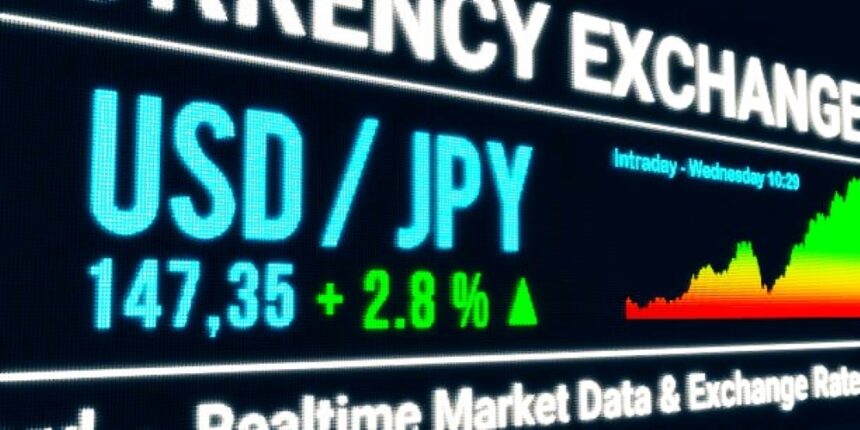The Japanese Yen (JPY) began the week on the back foot, plunging to its lowest level since May 15 against a broadly stronger US Dollar (USD) during Monday’s Asian session. Despite a stream of encouraging domestic data, the Yen struggled to attract buyers as investors weighed mixed macroeconomic signals from Japan against the resolute hawkish stance of the US Federal Reserve.
The Bank of Japan’s (BoJ) continued dovish posture—highlighted by its decision to slow the pace of bond purchase reductions beyond fiscal 2026—has cast doubt over any near-term tightening. Market participants now expect the next BoJ rate hike to come later than previously anticipated, which has placed heavy pressure on the JPY.
Adding to the downward pressure are intensifying trade concerns. Existing 25% US tariffs on Japanese vehicles and reciprocal duties on select American imports continue to dampen Japan’s trade outlook, adding another layer of caution for Yen bulls.
BoJ Remains Cautious Despite Inflation Staying Elevated
Last week, the BoJ reinforced its cautious tone by signaling a slower-than-expected approach to policy normalization. Despite three consecutive years of core inflation readings above the central bank’s 2% target, Governor Kazuo Ueda has indicated a desire to monitor economic and financial conditions further before taking decisive steps.
On Friday, Japan’s Core Consumer Price Index (CPI) came in at a more than two-year high for May, extending the streak of inflation exceeding the BoJ’s goal. However, rather than energizing the Japanese Yen, this data largely brushed off by traders who expect the BoJ to remain hesitant due to fragile domestic demand and external economic headwinds—including rising energy import costs and political uncertainties abroad.
Mixed Signals from PMI Keep Japanese yen Bulls at Bay
Despite pessimism surrounding monetary policy, Japan’s recent economic indicators suggest a slow but steady recovery. On Monday, the au Jibun Bank flash Purchasing Managers’ Index (PMI) pointed to broad-based strength across manufacturing and services.
- Manufacturing PMI: Rose from 49.4 to 50.4 in June, crossing the critical 50-mark that separates contraction from expansion for the first time since May 2024.
- Services PMI: Increased from 51.0 to 51.5, signaling sustained strength in Japan’s consumer-driven sector.
- Composite PMI: Advanced to 51.4 from May’s 50.2, its fastest pace of growth since February.
These figures hint at improving domestic sentiment and business activity, particularly in the face of weakening global demand. However, the data alone has not been strong enough to reverse the bearish pressure on the Yen amid broader market skepticism over BoJ tightening.
US Dollar Strength Reinforced by Hawkish Fed and Geopolitical Risks
The US Dollar remains buoyant as the Federal Reserve maintains its restrictive policy stance. While Fed Chair Jerome Powell and colleagues project two rate cuts in 2025, they’ve also forecast just one rate cut per year in both 2026 and 2027—highlighting a longer path toward policy easing than markets initially anticipated.
This outlook is being driven, in part, by concerns over inflationary pressures from the Trump administration’s sweeping tariff policy, which includes elevated duties on Chinese and Japanese imports. Fed officials worry these tariffs could lift consumer prices and delay progress on inflation.
As a result, US Treasury yields remain elevated, providing consistent support to the Greenback. The Fed’s policy divergence from the BoJ—one hawkish, one dovish—has created a widening yield differential that favors continued upside for the USDJPY pair.
Middle East Escalation Boosts USD Haven Appeal More Than Japanese yen
In theory, the Japanese Yen should benefit from escalating geopolitical tensions—especially its traditional role as a safe-haven currency. But this week’s events have painted a more complex picture.
On Sunday, the US military, in coordination with Israel, launched a series of precision airstrikes on Iranian nuclear facilities. Over 75 guided munitions, including Tomahawk missiles and air-to-ground weapons, were deployed against three critical sites, marking a significant escalation in the Iran-Israel conflict.
US Defense Secretary Pete Hegseth issued a stern warning to Iran, while Vice President JD Vance emphasized that the US is targeting Iran’s nuclear ambitions—not seeking a broader war. Nevertheless, markets are on edge, awaiting Tehran’s official response.
Traditionally, such geopolitical unrest would drive flows into the JPY, but this time, risk sentiment is being absorbed by the USD’s dominant role as the global reserve currency, particularly amid Fed-induced yield support. Thus, the JPY’s haven status has been largely sidelined.
Trade Tensions with the US Add to Japanese yen Woes
Beyond military concerns, economic tensions are also weighing on Japan. The White House has not lifted the 25% tariff on Japanese vehicles, a duty originally imposed during the previous Trump administration. Meanwhile, Japan has reciprocated with a 24% duty on selected US imports.
These mutual tariffs threaten to undermine Japan’s critical export sector, which is heavily reliant on automobile shipments. For a country still recovering from decades of deflation and stagnation, this additional stressor reduces the likelihood of bold policy tightening by the BoJ.
Technical Outlook: USDJPY Eyes Further Gains
From a technical perspective, the USD/JPY pair appears poised for further upside as it breaks key resistance levels. The next target for bulls lies near the 158.00–158.30 area, with a sustained move above potentially opening the door for a challenge of the multi-decade high around 160.00.
On the flip side, any retracement may find initial support near the 156.40–156.20 zone, followed by the 155.50 pivot, where recent dips have found buyers. However, a shift in global sentiment—especially a dovish surprise from the Fed or retaliatory action by Iran—could quickly change the trajectory.
Investor Focus: Iran’s Response and Japan’s Inflation Path
Going forward, markets will remain hyper-focused on two developments:
- Iran’s response to the US airstrikes. Any retaliatory action could reignite JPY safe-haven bids, particularly if oil prices surge or risk-off sentiment intensifies.
- Japan’s inflation trajectory and whether future CPI prints will force the BoJ’s hand. If upward pressure persists while economic indicators remain solid, the central bank may be compelled to revise its cautious stance.
Until then, however, interest rate differentials and geopolitical uncertainty continue to favor the USDJPY bulls.
[faq-schema id=”40076″]









